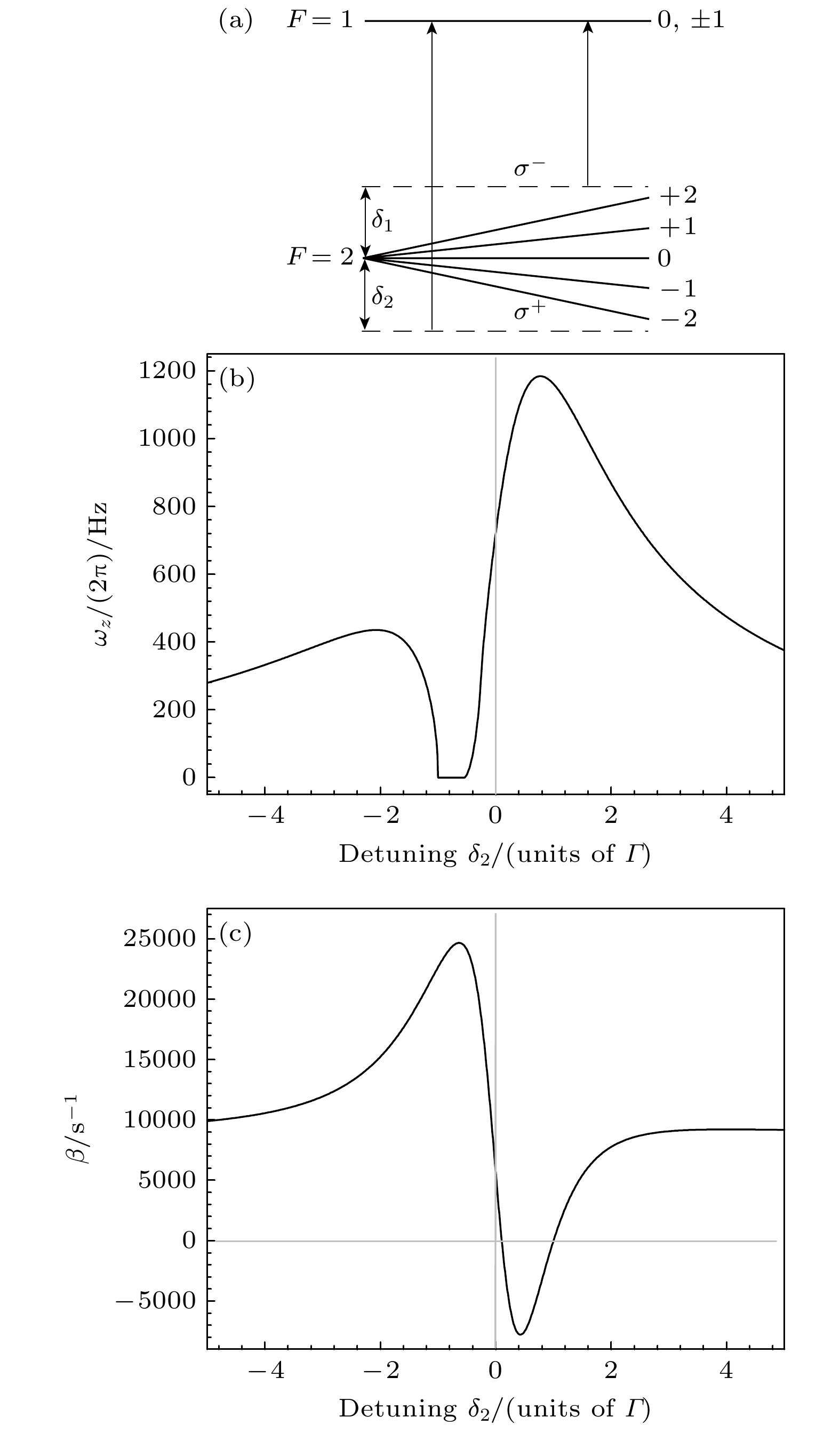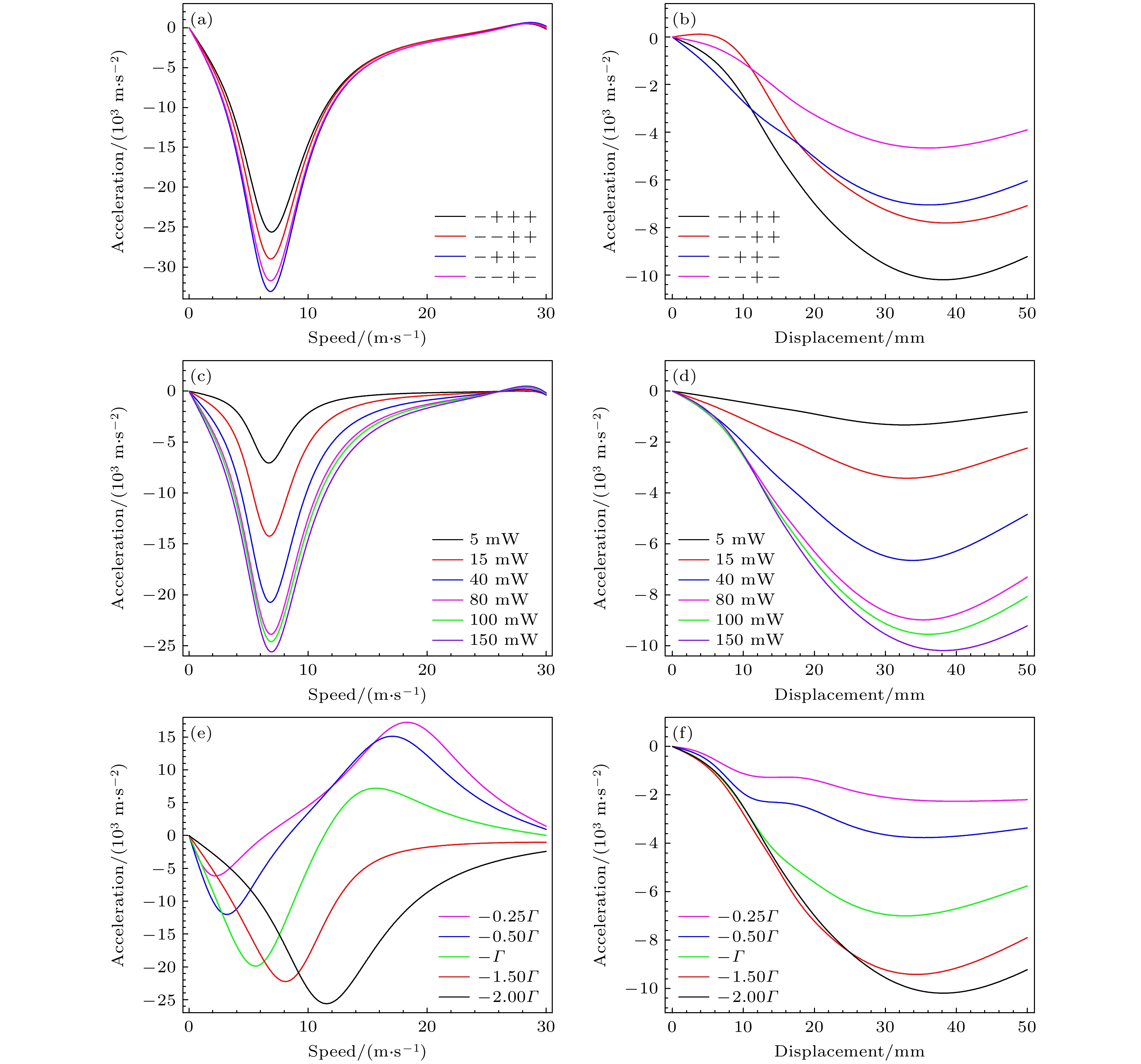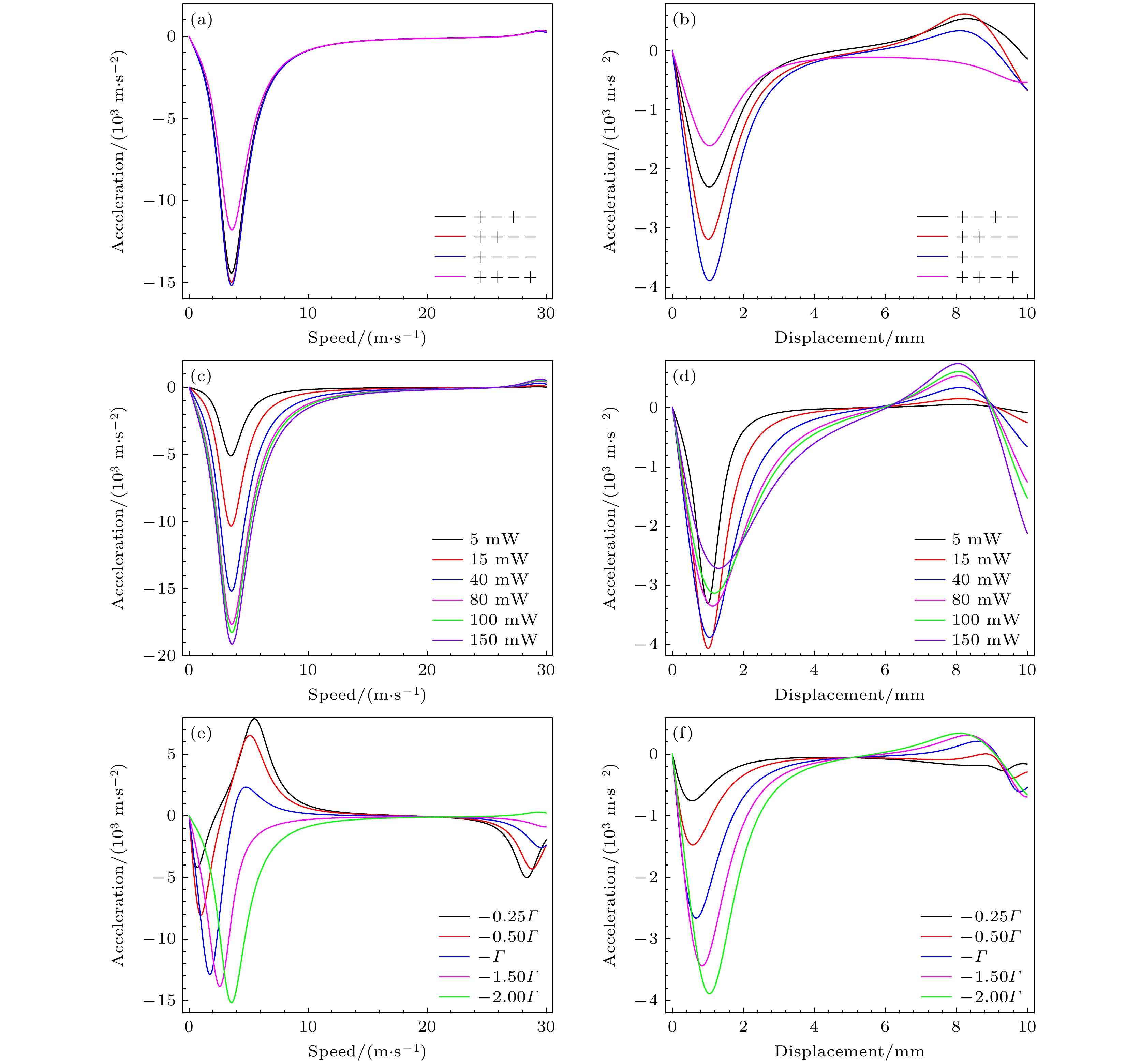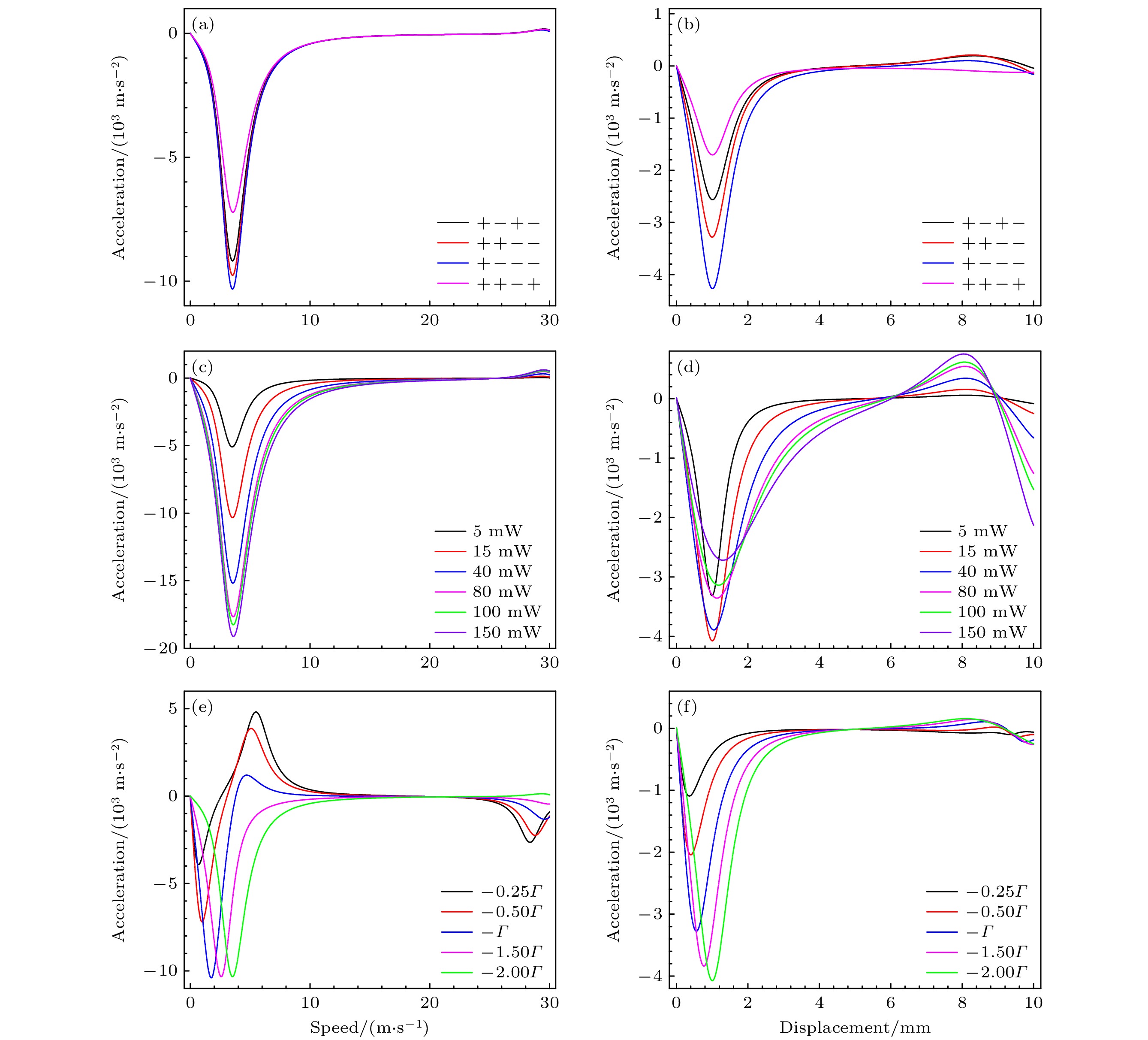-
Laser cooling and magneto-optical trapping of molecules is regarded as one of the state-of-the-art research fields in physics, which possesses broad applications in exploring fundamental physics beyond the Standard Model, quantum many-body physics, cold/ultracold chemistry and collision studies and so forth. Owing to the characteristic of highly diagonal Franck-Condon factors, lower saturation irradiance and larger scattering rate, the CaH molecule has been proposed as a promising candidate for laser cooling and magneto-optical trapping ever since 2004. Taking advantage of the multi-energy-level rate equation as well as the dual frequency effect, we evaluate the damping and trapping forces contained in the optical transitions of
$ {\mathrm{A}}^{2}{\mathrm{Π}}_{1/2}\leftarrow {\mathrm{X}}^{2}{\mathrm{Σ }}^{+} $ and${\mathrm{B}}^{2}{\mathrm{Σ }}^{+}\leftarrow {\mathrm{X}}^{2}{\mathrm{Σ }}^{+}$ , analyze the cooling and trapping performance for different laser polarization sets, power values and detunings of four laser components, and determine the variations in the damping and trapping forces due to an additional frequency component. It is discovered that if the laser polarization is set to be σ-σ+σ+σ+σ+, the detuning for the second laser component is Γwhile the detuning of other components are set to be -2Γ, and the laser power is set to be 150 mW, one can obtain a damping acceleration of 28000 m/s2, and a trapping acceleration of 19000 m/s2 for the transition of $ {\mathrm{A}}^{2}{\mathrm{Π}}_{1/2}\leftarrow {\mathrm{X}}^{2}{\mathrm{Σ }}^{+} $ , both of which reach the optimal values under the current scope of the research and exhibit better performance than the CaF molecule. Our results, on one hand, not only offer an ideal method to comprehend the CaH MOT in theory but also help design the CaH MOT experiment or even achieve the Bose-Einstein condensation (BEC) of cold diatomic molecules. On the other hand, alkaline-earth-metal monohydrides (AEMHs) such as CaH, SrH and BaH are well-known for their permanent electric dipole moment, therefore these trapped diatomic molecules can be utilized to untangle the mechanism of dipole-dipole interaction, thus paving the way to realizing the molecular entanglement and quantum computing. More interestingly, current experimental systems for the non-zero measurement of the electron’s electric dipole moment (eEDM), including ThO, YbF and HfF+, still cannot be conducted simultaneously under the laser cooling and magneto-optical trapping technique while maintaining the ease of full polarization and internal co-magnetometry, all of which undoubtedly can increase the coherent measurement time and hence the statistical sensitivity, as well as the immunity to the systematic sensitivity. Previous studies reported that AEMHs share some similar characters with alkaline-earth-metal monofluorides (AEMFs) such as in electron correlation effects, however, the hyperfine energy level structures of AEMHs are relatively simpler than those of AEMFs, and AEMHs are prone to being polarized under the externally applied electric field. All of these lead to the trend that AEMHs may possess the dual character that it can be not only laser cooled and trapped in a MOT but also adopted as an candidate to measure the eEDM. Therefore, our work lays a substantial foundation for the theoretical and experimental study of SrH and BaH that inevitably will contribute to the exploration of the CP violation and new physics beyond the Standard Model on a scientific platform based on cold polar molecules, which is obviously different from large facilities such as the Large Hadron Collider.[1] Hudson E R, Lewandowski H, Sawyer B C, Ye J 2006 Phys. Rev. Lett. 96 143004
 Google Scholar
Google Scholar
[2] Liu L, Hood J, Yu Y, Zhang J, Hutzler N, Rosenband T, Ni K K 2018 Science 360 900
 Google Scholar
Google Scholar
[3] Yang T, Thomas A M, Dangi B B, Kaiser R I, Mebel A M, Millar T J 2018 Nat. Commun. 9 1
 Google Scholar
Google Scholar
[4] Kerman A J, Sage J M, Sainis S, Bergeman T, DeMille D 2004 Phys. Rev. Lett. 92 153001
 Google Scholar
Google Scholar
[5] Wang D, Qi J, Stone M, Nikolayeva O, Wang H, Hattaway B, Gensemer S, Gould P, Eyler E, Stwalley W 2004 Phys. Rev. Lett. 93 243005
 Google Scholar
Google Scholar
[6] Ni K K, Ospelkaus S, De Miranda M, Pe'Er A, Neyenhuis B, Zirbel J, Kotochigova S, Julienne P, Jin D, Ye J 2008 Science 322 231
 Google Scholar
Google Scholar
[7] 陈涛, 颜波 2019 物理学报 68 043701
 Google Scholar
Google Scholar
Chen T, Yan B 2019 Acta Phys. Sin. 68 043701
 Google Scholar
Google Scholar
[8] Bruzewicz C, Gustavsson M, Shimasaki T, DeMille D 2014 New. J. Phys. 16 023018
 Google Scholar
Google Scholar
[9] Wu C H, Park J W, Ahmadi P, Will S, Zwierlein M W 2012 Phys. Rev. Lett. 109 085301
 Google Scholar
Google Scholar
[10] Jin D S, Ye J 2011 Phys. Today 64 27
[11] Bethlem H L, Berden G, Meijer G 1999 Phys. Rev. Lett. 83 1558
 Google Scholar
Google Scholar
[12] Barry J, McCarron D, Norrgard E, Steinecker M, DeMille D 2014 Nature 512 286
 Google Scholar
Google Scholar
[13] Weinstein J D, Decarvalho R, Amar K, Boca A, Odom B C, Friedrich B, Doyle J M 1998 J. Chem. Phys. 109 2656
 Google Scholar
Google Scholar
[14] 夏勇, 汪海玲, 许亮, 印建平 2018 物理学报 47 24
 Google Scholar
Google Scholar
Xia Y, Wang H L, Xu L, Yin J P 2018 Acta Phys. Sin. 47 24
 Google Scholar
Google Scholar
[15] Jochim S, Bartenstein M, Altmeyer A, Hendl G, Riedl S, Chin C, Hecker Denschlag J, Grimm R 2003 Science 302 2101
 Google Scholar
Google Scholar
[16] Greiner M, Regal C A, Jin D S 2003 Nature 426 537
 Google Scholar
Google Scholar
[17] Zhang Z, Chen L, Yao K X, Chin C 2021 Nature 592 708
 Google Scholar
Google Scholar
[18] Steinecker M H, McCarron D J, Zhu Y, DeMille D 2016 ChemPhysChem 17 3664
 Google Scholar
Google Scholar
[19] Tarbutt M, Steimle T 2015 Phys. Rev. A 92 053401
 Google Scholar
Google Scholar
[20] Truppe S, Williams H, Hambach M, Caldwell L, Fitch N, Hinds E, Sauer B, Tarbutt M 2017 Nat. Phys. 13 1173
 Google Scholar
Google Scholar
[21] Anderegg L, Augenbraun B L, Chae E, Hemmerling B, Hutzler N R, Ravi A, Collopy A, Ye J, Ketterle W, Doyle J M 2017 Phys. Rev. Lett. 119 103201
 Google Scholar
Google Scholar
[22] Langin T K, Jorapur V, Zhu Y, Wang Q, DeMille D 2021 Phys. Rev. Lett. 127 163201
 Google Scholar
Google Scholar
[23] Lu H I, Rasmussen J, Wright M J, Patterson D, Doyle J M 2011 Phys. Chem. Chem. Phys. 13 18986
 Google Scholar
Google Scholar
[24] 尹俊豪, 杨涛, 印建平 2021 物理学报 70 163302
 Google Scholar
Google Scholar
Yin J H, Yang T, Yin J P 2021 Acta Phys. Sin. 70 163302
 Google Scholar
Google Scholar
[25] Collopy A L, Ding S, Wu Y, Finneran I A, Anderegg L, Augenbraun B L, Doyle J M, Ye J 2018 Phys. Rev. Lett. 121 213201
 Google Scholar
Google Scholar
[26] Iwata G, McNally R, Zelevinsky T 2017 Phys. Rev. A 96 022509
 Google Scholar
Google Scholar
[27] Chen T, Bu W, Yan B 2017 Phys. Rev. A 96 053401
 Google Scholar
Google Scholar
[28] Gu R, Xia M, Yan K, Wu D, Wei J, Xu L, Xia Y, Yin J 2022 J. Quant. Spectrosc. Radiat. Transfer 278 108015
 Google Scholar
Google Scholar
[29] Kozyryev I, Baum L, Matsuda K, Augenbraun B L, Anderegg L, Sedlack A P, Doyle J M 2017 Phys. Rev. Lett. 118 173201
 Google Scholar
Google Scholar
[30] Baum L, Vilas N B, Hallas C, Augenbraun B L, Raval S, Mitra D, Doyle J M 2021 Phys. Rev. A 103 043111
 Google Scholar
Google Scholar
[31] Fazil N, Prasannaa V, Latha K, Abe M, Das B 2018 Phys. Rev. A 98 032511
 Google Scholar
Google Scholar
[32] Kozyryev I, Hutzler N R 2017 Phys. Rev. Lett. 119 133002
 Google Scholar
Google Scholar
[33] Barbuy B, Schiavon R, Gregorio-Hetem J, Singh P, Batalha C 1993 Astron. Astrophys. Suppl. Ser. 101 409
[34] Lépine S, Rich R M, Shara M M 2003 Astrophys. J. 591 L49
 Google Scholar
Google Scholar
[35] Barclay Jr W, Anderson M, Ziurys L M 1993 Astrophys. J. 408 L65
 Google Scholar
Google Scholar
[36] Steimle T, Chen J, Gengler J 2004 J. Chem. Phys. 121 829
 Google Scholar
Google Scholar
[37] Weinstein J D, DeCarvalho R, Guillet T, Friedrich B, Doyle J M 1998 Nature 395 148
 Google Scholar
Google Scholar
[38] Singh V, Hardman K S, Tariq N, Lu M J, Ellis A, Morrison M J, Weinstein J D 2012 Phys. Rev. Lett. 108 203201
 Google Scholar
Google Scholar
[39] Ramanaiah M, Lakshman S 1982 Physica 113C 263
 Google Scholar
Google Scholar
[40] Nakagawa J, Domaille P J, Steimle T C, Harris D O 1978 J. Mol. Spectrosc. 70 374
 Google Scholar
Google Scholar
[41] Shayesteh A, Ram R S, Bernath P F 2013 J. Mol. Spectrosc. 288 46
 Google Scholar
Google Scholar
[42] Gao Y, Gao T 2014 Phys. Rev. A 90 052506
 Google Scholar
Google Scholar
[43] Chen J, Gengler J, Steimle T, Brown J M 2006 Phys. Rev. A 73 012502
 Google Scholar
Google Scholar
[44] Barry J F, McCarron D J, Norrgard E B, Steinecker M H, DeMille D 2014 Nature 512 286
[45] Xu S, Xia M, Gu R, Yin Y, Xu L, Xia Y, Yin J 2019 Phys. Rev. A 99 033408
 Google Scholar
Google Scholar
[46] Tarbutt M 2015 New. J. Phys. 17 015007
 Google Scholar
Google Scholar
[47] Liu M, Pauchard T, Sjödin M, Launila O, van der Meulen P, Berg L E 2009 J. Mol. Spectrosc. 257 105
 Google Scholar
Google Scholar
[48] Xu L, Yin Y, Wei B, Xia Y, Yin J 2016 Phys. Rev. A 93 013408
 Google Scholar
Google Scholar
[49] Steimle T C, Meyer T P, Al-Ramadin Y, Bernath P 1987 J. Mol. Spectrosc. 125 225
 Google Scholar
Google Scholar
[50] Williams H, Truppe S, Hambach M, Caldwell L, Fitch N, Hinds E, Sauer B, Tarbutt M 2017 New J. Phys. 19 113035
 Google Scholar
Google Scholar
-
图 1 CaH分子
${\mathrm{{\rm X}}}^{2}{\mathrm{Σ }}^{+}(\upsilon =0, N=1)$ 电子态的塞曼分裂示意图. F表示总角动量, 括号里的数字是每一个超精细能级的g因子值Figure 1. The Zeeman level structure for the
${{{\rm X}}}^{2}{{\Sigma }}^{+}(\upsilon = $ $ 0, N=1)$ state of the CaH molecule. F represents the total angular momentum, while numbers in parentheses indicate the g factor for each hyperfine energy level.图 2 (a) 双频效应原理图. 基态能级Fl = 2, gl = 0.5, 激发态能级Fu = 1, gu = 0.不同偏振的频率分量激发同一能级, 失谐量分别是
$ {\delta }_{1} $ 和$ {\delta }_{2} $ . (b) 囚禁频率与失谐量$ {\delta }_{2} $ 的曲线图; (c)阻尼系数与失谐量$ {\delta }_{2} $ 的曲线图Figure 2. (a) Illustration of the dual-frequency effect with the ground energy level Fl = 2, gl = 0.5 and the excited energy level Fu = 1, gu = 0. Two transitions with oppositely polarized frequency components were driven, while the detunings are
$ {\delta }_{1} $ and$ {\delta }_{2} $ respectively. (b) Trap frequency versus$ {\delta }_{2} $ ; (c) Damping coefficient versus$ {\delta }_{2} $ .图 3 CaH分子MOT中
$ \mathrm{A}^{2}{\mathrm{Π}}_{1/2}\leftarrow {\mathrm{X}}^{2}{\mathrm{Σ}}^{+} $ 和${\mathrm{B}}^{2}{\mathrm{Σ }}^{+}\leftarrow {\mathrm{X}}^{2}{\mathrm{Σ }}^{+}$ 跃迁的频率分布方案Figure 3. Frequency distribution schemes for
${\mathrm{A}}^{2}{\mathrm{Π}}_{1/2}\leftarrow $ $ {\mathrm{X}}^{2}{\mathrm{Σ }}^{+}$ and${\mathrm{B}}^{2}{\mathrm{Σ }}^{+}\leftarrow {\mathrm{X}}^{2}{\mathrm{Σ }}^{+}$ transitions in a MOT of CaH.图 4 不同偏振组态下的加速度与(a)速度和(b)位移的关系图. 其中激光功率均为150 mW, 失谐为–2Γ. 不同激光功率下的加速度与(c)速度和(d)位移关系图. 其中频率组分的偏振组态为(–+++), 失谐为–2Γ. 不同失谐量下的加速度与(e)速度和(f)位移关系图. 其中激光功率均为150 mW, 频率组分的偏振组态为(–+++)
Figure 4. Acceleration versus (a) speed and (b) displacement under different polarization configurations where the power for lasers is set to be 150 mW and the detuning is –2Γ. Acceleration versus (c) speed and (d) displacement on different laser powers. The polarization configuration is (–+++), while the detuning is –2Γ. Acceleration versus (e) speed and (f) displacement on various detunings, where the laser power is set as 150 mW and the polarization configuration is (–+++).
图 5 加速度与(a)速度和(b)位移关系图. 激光频率偏振设置为插图中所示的情况, 其中激光功率均为150 mW. 除了额外加的频率失谐是Γ, 其他频率分量失谐都是–2Γ
Figure 5. Acceleration versus (a) speed and (b) displacement using the set of detunings and polarizations illustrated in the inset. Here, the laser power is set to be 150 mW. The detuning is –2Γ apart from the additional component of Γ.
图 6 不同偏振组态下的加速度与(a)速度和(b)位移关系图. 其中激光功率均为40 mW, 失谐为–2Γ. 不同功率下的加速度与(c)和速度(d)位移关系图. 其中偏振组态为(+–––), 失谐为–2Γ. 不同失谐量下的加速度与(e)速度和(f)位移关系图. 其中激光功率均为40 mW, 偏振组态为(+–––)
Figure 6. Acceleration versus (a) speed and (b) displacement under different polarization configurations where the power for lasers is set to be 40 mW and the detuning is –2Γ. Acceleration versus (c) speed and (d) displacement on different laser powers. The polarization configuration is (+–––), while the detuning is –2Γ. Acceleration versus (e) speed and (f) displacement on various detunings, where the laser power is set as 40 mW and the polarization configuration is (+–––).
图 7 加速度与(a)速度和(b)位移关系图. 激光频率偏振设置为插图中所示的情况, 其中激光功率均为40 mW. 除了额外加的频率失谐是1.5Γ, 其他频率分量失谐都是–2Γ
Figure 7. Acceleration versus (a) speed and (b) displacement using the set of detunings and polarizations illustrated in the inset. Here, the laser power is set to be 40 mW. The detuning is –2Γ apart from the additional component of 1.5Γ.
图 A1
${\mathrm{A}}^{2}{{\Pi }}_{1/2}\leftarrow {\mathrm{X}}^{2}{{\Sigma }}^{+}$ 跃迁中不同偏振组态下的加速度与(a)速度和(b)位移的关系图. 其中激光功率均为40 mW, 失谐为–2Γ. 不同激光功率下的加速度与(c)速度和(d)位移关系图. 其中四个频率组分的偏振组态为(–+++), 失谐为–2Γ. 不同失谐量下的加速度与(e)速度和(f)位移关系图. 其中激光功率均为40 mW, 频率组分的偏振组态为(–+++)Figure A1. Acceleration versus (a) speed and (b) displacement under different polarization configurations in the
$ {\mathrm{A}}^{2}{{\Pi }}_{1/2}\leftarrow {\mathrm{X}}^{2}{{\Sigma }}^{+} $ transition, where the power for lasers is set to be 40 mW and the detuning is –2Γ. Acceleration versus (c) speed and (d) displacement on different laser powers. The polarization configuration is (–+++), while the detuning is –2Γ. Acceleration versus (e) speed and (f) displacement on various detunings, where the laser power is set as 40 mW and the polarization configuration is (–+++).图 A2
$ {\mathrm{A}}^{2}{{\Pi }}_{1/2}\leftarrow {\mathrm{X}}^{2}{{\Sigma }}^{+} $ 跃迁中加速度与(a)速度和(b)位移关系图. 激光频率偏振设置为插图中所示的情况, 其中激光功率均为40 mW.除了额外加的频率失谐是Γ, 其他频率分量失谐都是–2ΓFigure A2. Acceleration versus (a) speed and (b) displacement in the
$ {\mathrm{A}}^{2}{{\Pi }}_{1/2}\leftarrow {\mathrm{X}}^{2}{{\Sigma }}^{+} $ transition, using the set of detunings and polarizations illustrated in the inset. Here, the laser power is set to be 40 mW. The detuning is –2Γ apart from the additional component of Γ.图 A3
${\mathrm{A}}^{2}{{\Pi }}_{1/2}\leftarrow {\mathrm{X}}^{2}{{\Sigma }}^{+}$ 跃迁中不同偏振组态下, 加速度与(a)速度和(b)位移的关系图. 其中激光功率均为80 mW, 失谐为–2Γ. 不同激光功率下的加速度与(c)速度和(d)位移关系图. 其中频率组分的偏振组态为(–+++), 失谐为–2Γ. 不同失谐量下的加速度与(e)速度和(f)位移关系图. 其中激光功率均为80 mW, 频率组分的偏振组态为(–+++)Figure A3. Acceleration versus (a) speed and (b) displacement under different polarization configurations in the
$ {\mathrm{A}}^{2}{{\Pi }}_{1/2}\leftarrow {\mathrm{X}}^{2}{{\Sigma }}^{+} $ transition, where the power for lasers is set to be 80 mW and the detuning is –2Γ. Acceleration versus (c) speed and (d) displacement on different laser powers. The polarization configuration is (–+++), while the detuning is –2Γ. Acceleration versus (e) speed and (f) displacement on various detunings, where the laser power is set as 80 mW and the polarization configuration is (–+++).图 A4
${\mathrm{A}}^{2}{{\Pi }}_{1/2}\leftarrow {\mathrm{X}}^{2}{{\Sigma }}^{+}$ 跃迁中加速度与(a)速度和(b)位移关系图. 激光频率偏振设置为插图中所示的情况, 其中激光功率均为80 mW. 除了额外加的频率失谐是Γ, 其他频率分量失谐都是–2ΓFigure A4. Acceleration versus (a) speed and (b) displacement in the
${\mathrm{A}}^{2}{{\Pi }}_{1/2}\leftarrow {\mathrm{X}}^{2}{{\Sigma }}^{+}$ transition, using the set of detunings and polarizations illustrated in the inset. Here, the laser power is set to be 80 mW. The detuning is –2Γ apart from the additional component of Γ.图 A5
$ {\mathrm{B}}^{2}{{\Sigma }}^{+}\leftarrow {\mathrm{X}}^{2}{{\Sigma }}^{+} $ 跃迁中不同偏振组态下的加速度与(a)速度和(b)位移的关系图. 其中激光功率均为15 mW, 失谐为–2Γ. 不同激光功率下的加速度与(c)速度和(d)位移关系图. 其中频率组分的偏振组态为(+–––), 失谐为–2Γ. 不同失谐量下的加速度与(e)速度和(f)位移关系图. 其中激光功率均为15 mW, 频率组分的偏振组态为(+–––)Figure A5. Acceleration versus (a) speed and (b) displacement under different polarization configurations in the
$ {\mathrm{B}}^{2}{{\Sigma }}^{+}\leftarrow {\mathrm{X}}^{2}{{\Sigma }}^{+} $ transition, where the power for lasers is set to be 15 mW and the detuning is –2Γ. Acceleration versus (c) speed and (d) displacement on different laser powers. The polarization configuration is (+–––), while the detuning is –2Γ. Acceleration versus (e) speed and (f) displacement on various detunings, where the laser power is set as 15 mW and the polarization configuration is (+–––).图 A6
$ {\mathrm{B}}^{2}{{\Sigma }}^{+}\leftarrow {\mathrm{X}}^{2}{{\Sigma }}^{+} $ 跃迁中加速度与(a)速度和(b)位移关系图. 激光频率偏振设置为插图中所示的情况, 其中激光功率均为15 mW. 除了额外加的频率失谐是1.5Γ, 其他频率分量失谐都是–2ΓFigure A6. Acceleration versus (a) speed and (b) displacement in the
$ {\mathrm{B}}^{2}{{\Sigma }}^{+}\leftarrow {\mathrm{X}}^{2}{{\Sigma }}^{+} $ transition, using the set of detunings and polarizations illustrated in the inset. Here, the laser power is set to be 15 mW. The detuning is –2Γ apart from the additional component of 1.5Γ.图 A7
$ {\mathrm{B}}^{2}{{\Sigma }}^{+}\leftarrow {\mathrm{X}}^{2}{{\Sigma }}^{+} $ 跃迁中不同偏振组态下的加速度与(a)速度和(b)位移的关系图. 其中激光功率均为80 mW, 失谐为–2Γ. 不同激光功率下的加速度与(c)速度和(d)位移关系图. 其中频率组分的偏振组态为(+–––), 失谐为–2Γ. 不同失谐量下的加速度与(e)速度和(f)位移关系图. 其中激光功率均为80 mW, 频率组分的偏振组态为(+–––)Figure A7. Acceleration versus (a) speed and (b) displacement under different polarization configurations in the
$ {\mathrm{B}}^{2}{{\Sigma }}^{+}\leftarrow {\mathrm{X}}^{2}{{\Sigma }}^{+} $ transition, where the power for lasers is set to be 80 mW and the detuning is –2Γ. Acceleration versus (c) speed and (d) displacement on different laser powers. The polarization configuration is (+–––), while the detuning is –2Γ. Acceleration versus (e) speed and (f) displacement on various detunings, where the laser power is set as 80 mW and the polarization configuration is (+–––).图 A8
$ {\mathrm{B}}^{2}{{\Sigma }}^{+}\leftarrow {\mathrm{X}}^{2}{{\Sigma }}^{+} $ 跃迁中加速度与(a)速度和(b)位移关系图. 激光频率偏振设置为插图中所示的情况, 其中激光功率均为80 mW. 除了额外加的频率失谐是1.5Γ, 其他频率分量失谐都是–2ΓFigure A8. Acceleration versus (a) speed and (b) displacement in the
$ {\mathrm{B}}^{2}{{\Sigma }}^{+}\leftarrow {\mathrm{X}}^{2}{{\Sigma }}^{+} $ transition, using the set of detunings and polarizations illustrated in the inset. Here, the laser power is set to be 80 mW. The detuning is –2Γ apart from the additional component of 1.5Γ. -
[1] Hudson E R, Lewandowski H, Sawyer B C, Ye J 2006 Phys. Rev. Lett. 96 143004
 Google Scholar
Google Scholar
[2] Liu L, Hood J, Yu Y, Zhang J, Hutzler N, Rosenband T, Ni K K 2018 Science 360 900
 Google Scholar
Google Scholar
[3] Yang T, Thomas A M, Dangi B B, Kaiser R I, Mebel A M, Millar T J 2018 Nat. Commun. 9 1
 Google Scholar
Google Scholar
[4] Kerman A J, Sage J M, Sainis S, Bergeman T, DeMille D 2004 Phys. Rev. Lett. 92 153001
 Google Scholar
Google Scholar
[5] Wang D, Qi J, Stone M, Nikolayeva O, Wang H, Hattaway B, Gensemer S, Gould P, Eyler E, Stwalley W 2004 Phys. Rev. Lett. 93 243005
 Google Scholar
Google Scholar
[6] Ni K K, Ospelkaus S, De Miranda M, Pe'Er A, Neyenhuis B, Zirbel J, Kotochigova S, Julienne P, Jin D, Ye J 2008 Science 322 231
 Google Scholar
Google Scholar
[7] 陈涛, 颜波 2019 物理学报 68 043701
 Google Scholar
Google Scholar
Chen T, Yan B 2019 Acta Phys. Sin. 68 043701
 Google Scholar
Google Scholar
[8] Bruzewicz C, Gustavsson M, Shimasaki T, DeMille D 2014 New. J. Phys. 16 023018
 Google Scholar
Google Scholar
[9] Wu C H, Park J W, Ahmadi P, Will S, Zwierlein M W 2012 Phys. Rev. Lett. 109 085301
 Google Scholar
Google Scholar
[10] Jin D S, Ye J 2011 Phys. Today 64 27
[11] Bethlem H L, Berden G, Meijer G 1999 Phys. Rev. Lett. 83 1558
 Google Scholar
Google Scholar
[12] Barry J, McCarron D, Norrgard E, Steinecker M, DeMille D 2014 Nature 512 286
 Google Scholar
Google Scholar
[13] Weinstein J D, Decarvalho R, Amar K, Boca A, Odom B C, Friedrich B, Doyle J M 1998 J. Chem. Phys. 109 2656
 Google Scholar
Google Scholar
[14] 夏勇, 汪海玲, 许亮, 印建平 2018 物理学报 47 24
 Google Scholar
Google Scholar
Xia Y, Wang H L, Xu L, Yin J P 2018 Acta Phys. Sin. 47 24
 Google Scholar
Google Scholar
[15] Jochim S, Bartenstein M, Altmeyer A, Hendl G, Riedl S, Chin C, Hecker Denschlag J, Grimm R 2003 Science 302 2101
 Google Scholar
Google Scholar
[16] Greiner M, Regal C A, Jin D S 2003 Nature 426 537
 Google Scholar
Google Scholar
[17] Zhang Z, Chen L, Yao K X, Chin C 2021 Nature 592 708
 Google Scholar
Google Scholar
[18] Steinecker M H, McCarron D J, Zhu Y, DeMille D 2016 ChemPhysChem 17 3664
 Google Scholar
Google Scholar
[19] Tarbutt M, Steimle T 2015 Phys. Rev. A 92 053401
 Google Scholar
Google Scholar
[20] Truppe S, Williams H, Hambach M, Caldwell L, Fitch N, Hinds E, Sauer B, Tarbutt M 2017 Nat. Phys. 13 1173
 Google Scholar
Google Scholar
[21] Anderegg L, Augenbraun B L, Chae E, Hemmerling B, Hutzler N R, Ravi A, Collopy A, Ye J, Ketterle W, Doyle J M 2017 Phys. Rev. Lett. 119 103201
 Google Scholar
Google Scholar
[22] Langin T K, Jorapur V, Zhu Y, Wang Q, DeMille D 2021 Phys. Rev. Lett. 127 163201
 Google Scholar
Google Scholar
[23] Lu H I, Rasmussen J, Wright M J, Patterson D, Doyle J M 2011 Phys. Chem. Chem. Phys. 13 18986
 Google Scholar
Google Scholar
[24] 尹俊豪, 杨涛, 印建平 2021 物理学报 70 163302
 Google Scholar
Google Scholar
Yin J H, Yang T, Yin J P 2021 Acta Phys. Sin. 70 163302
 Google Scholar
Google Scholar
[25] Collopy A L, Ding S, Wu Y, Finneran I A, Anderegg L, Augenbraun B L, Doyle J M, Ye J 2018 Phys. Rev. Lett. 121 213201
 Google Scholar
Google Scholar
[26] Iwata G, McNally R, Zelevinsky T 2017 Phys. Rev. A 96 022509
 Google Scholar
Google Scholar
[27] Chen T, Bu W, Yan B 2017 Phys. Rev. A 96 053401
 Google Scholar
Google Scholar
[28] Gu R, Xia M, Yan K, Wu D, Wei J, Xu L, Xia Y, Yin J 2022 J. Quant. Spectrosc. Radiat. Transfer 278 108015
 Google Scholar
Google Scholar
[29] Kozyryev I, Baum L, Matsuda K, Augenbraun B L, Anderegg L, Sedlack A P, Doyle J M 2017 Phys. Rev. Lett. 118 173201
 Google Scholar
Google Scholar
[30] Baum L, Vilas N B, Hallas C, Augenbraun B L, Raval S, Mitra D, Doyle J M 2021 Phys. Rev. A 103 043111
 Google Scholar
Google Scholar
[31] Fazil N, Prasannaa V, Latha K, Abe M, Das B 2018 Phys. Rev. A 98 032511
 Google Scholar
Google Scholar
[32] Kozyryev I, Hutzler N R 2017 Phys. Rev. Lett. 119 133002
 Google Scholar
Google Scholar
[33] Barbuy B, Schiavon R, Gregorio-Hetem J, Singh P, Batalha C 1993 Astron. Astrophys. Suppl. Ser. 101 409
[34] Lépine S, Rich R M, Shara M M 2003 Astrophys. J. 591 L49
 Google Scholar
Google Scholar
[35] Barclay Jr W, Anderson M, Ziurys L M 1993 Astrophys. J. 408 L65
 Google Scholar
Google Scholar
[36] Steimle T, Chen J, Gengler J 2004 J. Chem. Phys. 121 829
 Google Scholar
Google Scholar
[37] Weinstein J D, DeCarvalho R, Guillet T, Friedrich B, Doyle J M 1998 Nature 395 148
 Google Scholar
Google Scholar
[38] Singh V, Hardman K S, Tariq N, Lu M J, Ellis A, Morrison M J, Weinstein J D 2012 Phys. Rev. Lett. 108 203201
 Google Scholar
Google Scholar
[39] Ramanaiah M, Lakshman S 1982 Physica 113C 263
 Google Scholar
Google Scholar
[40] Nakagawa J, Domaille P J, Steimle T C, Harris D O 1978 J. Mol. Spectrosc. 70 374
 Google Scholar
Google Scholar
[41] Shayesteh A, Ram R S, Bernath P F 2013 J. Mol. Spectrosc. 288 46
 Google Scholar
Google Scholar
[42] Gao Y, Gao T 2014 Phys. Rev. A 90 052506
 Google Scholar
Google Scholar
[43] Chen J, Gengler J, Steimle T, Brown J M 2006 Phys. Rev. A 73 012502
 Google Scholar
Google Scholar
[44] Barry J F, McCarron D J, Norrgard E B, Steinecker M H, DeMille D 2014 Nature 512 286
[45] Xu S, Xia M, Gu R, Yin Y, Xu L, Xia Y, Yin J 2019 Phys. Rev. A 99 033408
 Google Scholar
Google Scholar
[46] Tarbutt M 2015 New. J. Phys. 17 015007
 Google Scholar
Google Scholar
[47] Liu M, Pauchard T, Sjödin M, Launila O, van der Meulen P, Berg L E 2009 J. Mol. Spectrosc. 257 105
 Google Scholar
Google Scholar
[48] Xu L, Yin Y, Wei B, Xia Y, Yin J 2016 Phys. Rev. A 93 013408
 Google Scholar
Google Scholar
[49] Steimle T C, Meyer T P, Al-Ramadin Y, Bernath P 1987 J. Mol. Spectrosc. 125 225
 Google Scholar
Google Scholar
[50] Williams H, Truppe S, Hambach M, Caldwell L, Fitch N, Hinds E, Sauer B, Tarbutt M 2017 New J. Phys. 19 113035
 Google Scholar
Google Scholar
Catalog
Metrics
- Abstract views: 6263
- PDF Downloads: 82
- Cited By: 0




















 DownLoad:
DownLoad:












































